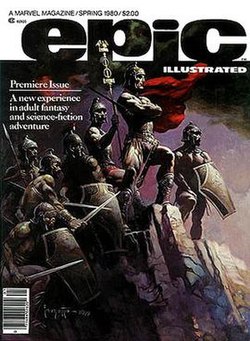Epic Illustrated
| Epic Illustrated | |
|---|---|
 Epic Illustrated #1 (Spring 1980), cover painting by Frank Frazetta. | |
| Publication information | |
| Publisher | Marvel Comics/Epic Comics |
| Format | Ongoing series |
| Publication date | Spring 1980 – February 1986 |
| No. of issues | 34 |
| Editor(s) | Archie Goodwin |
Epic Illustrated was a
A color comic-book imprint, Epic Comics, was spun off in 1982.
Publication history
The magazine was initiated under editor Rick Marschall in 1979 under the title Odyssey, and originally set to launch as an issue of Marvel Super Special.[1] After Marschall learned of at least seven other magazines titled Odyssey, the project was renamed Epic Illustrated and launched as a standalone series.[2] Marschall was replaced by editor Archie Goodwin in September 1979, several months before the first issue was published.[3]
Stories, series and format
The anthology featured heroic fiction and genre stories, primarily
Epic Illustrated also included an occasional Marvel Comics protagonist, such as the first issue's Silver Surfer story by Stan Lee and John Buscema. Each issue usually featured a main story, a number of regular serials, and anthological shorts.[4]
Writer-penciler John Byrne and inker Terry Austin produced "The Last Galactus Story" as a serial in Epic Illustrated #26-34 (Oct. 1984 - Feb. 1986). Nine of a scheduled 10 installments appeared. Each ran six pages, except part eight, which ran 12.
Cancellation
Due to its expensive nature to the company and low sales, the magazine was canceled with issue #34, leaving the last chapter of "Galactus" unpublished and the story unfinished. Byrne later revealed on his website that the conclusion would have seen a dying Galactus releasing his power, causing a new big bang and transforming his herald Nova into the Galactus of the next universe.[8]
Selected stories
- "Metamorphosis Odyssey" a serial by Jim Starlin in issues #1-9 (Spring 1980 - Dec. 1981), which introduced his Dreadstar character.
- "A Tale Of Elric of Melniboné: The Dreaming City" by Michael Moorcock, Roy Thomas, and P. Craig Russell in issues #3 (Fall 1980), #4 (Winter 1980), and #14 (Oct. 1982).
- Ken Steacy's adaptations of Harlan Ellison's short stories: "Sleeping Dogs" in issue #4 (Winter 1980), "Life Hutch" in #6 (June 1981), and "Run for the Stars" in #11 (April 1982).
- "Abraxas and the Earthman" by Rick Veitch in issues #10-17 (Feb. 1982 - April 1983).
- "Marada" by Chris Claremont and John Bolton in issues #10-12 (Feb.-June 1982) and #22-23 (Feb.-April 1984).
- "Last of the Dragons" by Carl Potts with Dennis O'Neil, Terry Austin, and Marie Severin in issues #15-20 (Dec. 1982 - Oct. 1983).[9]
- "Generation Zero" by Pepe Moreno and Archie Goodwin in issues #17-24 (April 1983 - June 1984).
- "The Sacred and The Profane" by Dean Motter and Ken Steacy in issues #20-26 (Oct. 1983 - Oct. 1984).
- "Young Cerebus" a series of vignettes of the early life of Cerebus by Dave Simin issues #26 (Oct. 1984), #28 (Feb. 1985), and #30 (June 1985).
Collected editions
- ISBN 978-0785199038
- Night and the Enemy includes the stories "Sleeping Dogs", "Life Hutch", and "Run for the Stars" from Epic Illustrated #3-4, and #14, ISBN 978-0486799612
- ISBN 978-0785162889
- Abraxas and the Earthman collects the serial from Epic Illustrated #10-17, King Hell Press, 88 pages, October 2006, ISBN 978-0962486487
- ISBN 978-0871351531
- Last of the Dragons collects the serial from Epic Illustrated #15-20, Epic Comics, 64 pages, April 1988, ISBN 978-0486803579
- Generation Zero collects the serial from Epic Illustrated #17-24, ISBN 978-1563890178
- The Sacred and the Profane collects the serial from Epic Illustrated #20-26, ISBN 978-0913035184
- ISBN 978-0785185437
- Toadswart d'Amplestone by Tim A. Conrad collects the serial from Epic Illustrated #25-28, 30–33, Eclipse Books, 106 pages, June 1990, ISBN 1-56060-013-6
See also
References
- Fantagraphics Books: 12. May 1979.
- ^ Lee, Stan. "Bullpen Bulletins: Stan's Soapbox", Marvel Two-in-One Annual #4 (Marvel Comics, 1979).
- ^ "Marvel Fires Rick Marschall, Archie Goodwin Named to Edit Epic". The Comics Journal (51). Stamford, Connecticut: Fantagraphics Books: 5–6. November 1979.
- ^ a b Kirk, John K. (May 2016). "Epic Illustrated". Back Issue! (88). Raleigh, North Carolina: TwoMorrows Publishing: 59–72.
- ISBN 9780810938212.
Oversize, with full-color artwork printed on glossy paper, Epic Illustrated was Marvel's most luxurious publication to date.
- ^ "Epic Illustrated Magazine List". Heavy Metal Magazine Fan Page. Archived from the original on May 27, 2012.
- ISBN 978-0756641238.
Epic offered its creators ownership of the material and paid them royalties rather than the traditional page rates.
- ^ Byrne, John (n.d.). "Byrne Robotics: Frequently Asked Questions - Questions about Aborted Storylines". Byrnerobotics.com. Archived from the original on October 31, 2014.
- ^ Dueben, Alex (March 1, 2016). "Former Marvel Editor Returns to 'Last of the Dragons', Talks Mentoring Talent". Comic Book Resources. Archived from the original on June 5, 2016.
One of Potts' first comics projects, 'Last of the Dragons', originally published in Epic Illustrated, has been repackaged and released by Dover Books. The story, written and illustrated by the comics veteran in the early '80s, has a unique take on monks, ninjas, samurais and dragons as a group of monks in 19th Century Japan have trained dragons and plan to bring them to America.
External links
- Epic Illustrated at the Comic Book DB (archived from the original)
- Epic Illustrated at the Grand Comics Database
- Epic Illustrated at the Unofficial Handbook of Marvel Comics Creators
